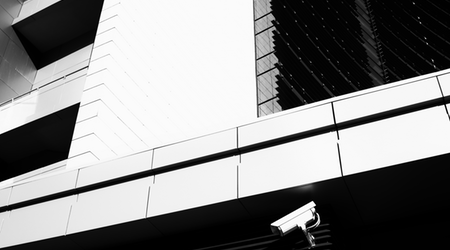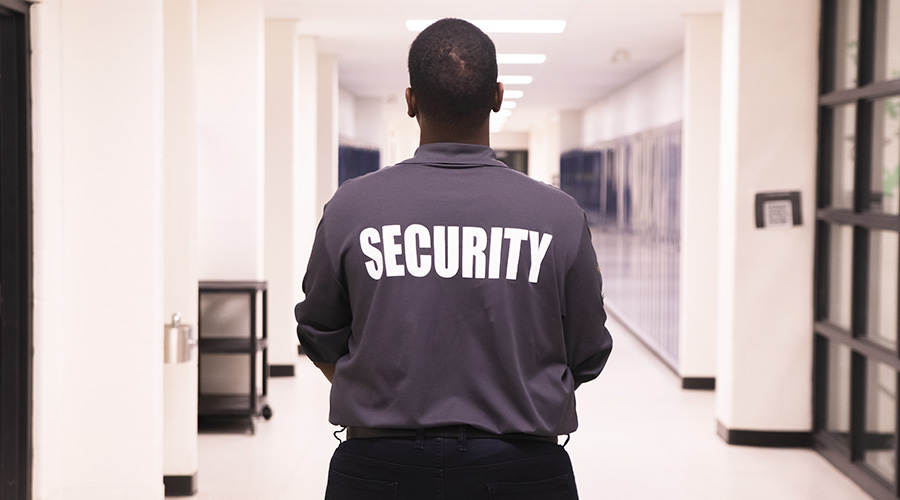Threat of Terror
There is no formula for safety, but facility executives can take steps to protect buildings and the people inside
The lingering anxiety over the Sept. 11 terrorist attacks is causing facility executives to re-evaluate their vulnerability. “Physical protection” has become a standard budget line for facility designers. And security experts are suddenly on center stage. Meanwhile, New York City and Washington, D.C., are brimming with research teams investigating the structural collapse of the World Trade Center and the design of the Pentagon. All this activity is unearthing a wealth of data that will be useful for facility executives.
The American Society of Heating, Refrigerating and Air-Conditioning Engineers (ASHRAE) and The Infrastructure Security Partnership (TISP) are just two of several groups about to issue recommendations for improving health and safety in existing buildings and in new building design.
But facility executives don’t have to wait for these recommendations. Research has been on the increase since the 1980s, producing important data on “standoff distances,” controlled access techniques, blast-resistant glazing and protective wall wraps.
Some of the best — and most dramatic — research comes from a little-known federal program called the Blast Mitigation for Structures Program (BMSP), a seven-year, $70-million effort launched in 1997.
BMSP researchers built a four-story, 30,000-square-foot concrete building near White Sands, N.M., and then rocked it with explosion after explosion. They evaluated windows, walls and structural elements following blasts containing up to 1,000 pounds of explosives. They also performed reduced scale component and product testing at a government research base in Vicksburg, Miss. Findings in this ongoing program are said to be as applicable to earthquakes and tornadoes as to explosives.
The study’s primary finding was that “progressive collapse” is the leading cause of injury and death in building explosions, with flying debris (primarily from glass) close behind. Progressive collapse — where a collapsing floor takes down the floor beneath it — is now being mitigated by strengthening the connection between beams, columns and floor slabs. But the report contains no magic formula for safety.
“They’ve come up with a whole range of methods and materials that have to be fit to a specific situation, depending on what the perceived threat level is,” says Richard Little, director of the National Research Council, which helps oversee the program. “People will need to know which materials and techniques to use in specific situations. It’s not ‘Just do this and you’ll be safe.’”
Here is the Web site for the Blast Mitigation Action Group. Much of the information on that site is now behind password protection.
Before any measures are adopted, the facility executive should obtain a threat assessment from a firm with a broad background in designing security solutions for explosions and biological and chemical threats. Most facilities are vulnerable to both.
Work with an expert to determine the building’s perceived vulnerability — taking into account its location, type of business, history and clientele.
Experts agree the first rule in protecting a building from explosions is to increase “standoff distance.” A simple definition — “how far you are from where a bomb could go off” — may apply to car bombs, but explosives can also be carried in a knapsack or briefcase. A better definition might be “the distance that allows facility executives the space and time to deal with threats they’re likely to face, based on the building’s architecture, its function, and how it’s laid out.” The Vice President’s residence has a standoff distance of about 250 yards (from house to fence). That will deter any car bomb, though probably not a bazooka. Generally, security experts wouldn’t consider a man with a bazooka a probable threat, so if it weren’t the Vice President, they wouldn’t bother calculating the travel distance of a bazooka shell.
It’s important to note that distance is critical with regard to explosives. The damaging energy from an explosion decreases rapidly the farther it travels. Therefore, simply increasing a standoff distance from 20 to 50 feet can be very significant.
Increasing standoff distance is easiest in suburban settings. Cars are kept far from new federal facilities by setting the building back from the street and using fencing or landscaping to funnel foot traffic into an elongated corridor. This restricts access and enables closer screening. Some facilities are designed with rounded edges or only the outside corners exposed; this deflects blast impact more effectively.
There are literally hundreds of explosions near buildings in the United States annually, according to Little, with abortion clinics a common target. Most only make news regionally because they are relatively small explosives instead of car bombs.
Urban buildings are susceptible to collateral damage from an event next door and are more difficult to evacuate than suburban buildings. Still, facility executives can provide a more secure envelope around urban buildings with greater use of video monitoring and rooftop inspection, increased lighting and brighter exterior colors, smoke control devices, infrared movement detectors or even anti-ram walls if the perceived threat is high. They can control how automobiles enter a garage and screen all bags. They can re-evaluate employees and hiring practices, and update disaster plans.
Facility executives can also secure overhead lights and HVAC ductwork, and bolt heavy bookcases to walls. San Francisco residents know the routine well.
Times may seem bleak, but experts say the typical facility executive should not try to prepare a building against suicide airplane attacks that are unlikely to happen. Far better, they say, to prepare a building well for smaller unwelcome events.
Blast-Resistant Glazing
If the perceived threat is high, the building owner should strongly consider shatter-resistant windows (ballistic glass). Installing thick, hardened glass in a steel frame can effectively disperse blast pressure from the glass to the frame to the walls. The better the grade, the higher the cost.
“There’s not much beyond building collapse and flying debris that causes injury and death in explosions,” says Little. “And if you’re already putting in new windows or building a new building, the extra cost to install blast-resistant windows is not astronomical. Buildings in areas with recurrent tornadoes or earthquakes may need wind- or shock-resistant windows anyway.”
Transparent, shatter-resistant window film, spread over the glass surface, can also disperse blast energy. But not even manufacturers would suggest that it’s as strong as ballistic glass. Window film’s primary purpose is to hold glass panes together so they don’t shatter into fragments that lacerate everything in their path. If the full frame does dislodge, architects say, it is less likely to hit someone. The framing around the glass can be reinforced or extra bars installed to provide strength that rivals lower grade ballistic glass, but at less cost. Thin curtain-like meshing can be added to catch panes that dislodge.
Bob Barr, a specialist at HOK, cautions against relying too heavily on window film. “It’s strictly there to prevent the glass from shattering,” Barr says. “It helps a little in resisting impact, but don’t let anybody tell you that it helps very much.”
But window film can be valuable in the right application. Consider NASDAQ. The Sept. 11 explosions blew out 600 windows at the company’s headquarters near the WTC and covered the interior with smoke, dust and debris. They wanted to reduce the risk of anything similar at their high-profile television studio in midtown Manhattan. The studio is famous for its transparent three-story entrance made of rounded, tempered glass. It also houses more than $8 million worth of very visible computer equipment and frequently plays host to celebrities, even foreign ambassadors. Owners realized it was a serious security risk, not just from explosions but also from regular firearms.
Al Bostdorf, security manager, says the bid for replacing the exterior with ballistic glass was $1.5 million. Instead, the company applied three layers of window film from a leading manufacturer for $300,000 and spent some of the money that would have gone to ballistic glass for improvements inside the building, including adding window film to some interior glass partitions.
The U.S. General Services Administration’s protection chart for government buildings runs from level 1 (“glazing does not break”) to level 5 (“window fails catastrophically”). Most federal buildings are held to a standard of 3a (“glazing cracks, fragments fly no further than 3.3 feet”). But GSA use is always guided by the perceived threat, which means federal courthouses may have ballistic glass installed in exposed areas and film in others — though they never go below a 4 mil thickness. (Window film thickness ranges up to about 10 mil.) A GSA spokesman said that since the terrorist attacks, the agency is more likely than before to move a project’s specs up one level.
Windows were a key focus in the renovation of the Pentagon, begun back in the mid-1990s. As part of the project, heavy, reinforced windows are being installed as sections or “wedges” are being renovated to provide substantial blast protection to the outer and inner rings. Each window unit weighs about 1,600 pounds and is supported on both sides by steel tubes that run the height of the five-story building. The window frames are bolted to these steel tubes. The glass is 1.5 inches thick with a layer of material sandwiched in between to further improve blast resistance. Beneath each window is a steel plate also attached to the steel tubes.
Hardening the Building
Walls, as well as windows, can be “hardened” to prepare a building for impact, and wrapping the inside of exterior walls can be very effective. Materials used range from Kevlar sheets glued or bolted in place, to rubbery substances that are applied with a spray gun. It may not protect a wall from collapse for very long, but it will save lives by preventing concrete from spraying out like shards of glass.
As part of the renovation of the Pentagon, crews wrapped Kevlar fabric around a steel grid that runs on both sides of the windows and up all five floors of the building.
“If the masonry fragments become a projectile, this stuff stretches way out to reduce the effect of the velocity,” says Walker Lee Evey, program manager for the Pentagon renovation. He said he may switch to a spray-on material for Wedge 2 as new products become available.
When the attack came on Sept. 11, Wedge 1 was nearly finished — workers from Wedge 2 were being moved into Wedge 1 so that renovation could start there. The hijacked airliner destroyed parts of both sections, but measures taken during the renovation — including the reinforced steel windows, added steel beams and the Kevlar mesh — saved many lives. Of the 2,600 workers in the immediate area when the aircraft hit, the vast majority survived; 125 were killed.
Biological and Chemical Threats
Biological agents like anthrax and smallpox are considered much more deadly than chemical agents like nerve gas, and the symptoms take longer to surface. It might take days for someone to realize he or she is carrying — and possibly spreading — a deadly biological agent.
“We do not yet have the technology that will detect biohazards quickly,” says Medhat O’Kelly, senior supervising engineer for Parsons Brinckerhoff. “The quickest we have now, I think, is two days. Researchers are working hard to reduce that level to a couple of hours. Until then, vigilance is the building executive’s prime weapon.
“Prevent the source from getting into your building by restricting access and protecting the air intake and vents,” says O’Kelly. Some experts now suggest placing air intakes as much as four floors up from street level. If that’s not possible, secure the air intake with fencing and install surveillance cameras. And locking the mechanical doors won’t seal off the building if a vent door is left open.
Some building owners have moved ancillary functions like mail centers or lobbies to adjacent office space. That retains convenience while introducing a physical barrier as protection against both explosions and biological or chemical agents. Experts also urge building owners to secure access to the bottom areas of elevator shafts, where intruders could gain access to other areas of a building.
Once hazardous agents enter the airflow, things can get serious. Anthrax spores can be reduced in number by better filtration, increasing the number of air changes, keeping air coils clean and using UV lighting. But it may be years before commercially available sensors can properly detect and differentiate between deadly and benign particles and then automatically shut a ventilation system down. Researchers are investigating advances in high-efficiency particulate air (HEPA) filtration, which is difficult in retrofits, and electrostatic collection solutions.
Those who can afford it can do what some emergency rooms do — buy another air handling system with special filters that can be turned on to keep the building properly pressurized if a hazard is detected. A more cost-effective solution is to make sure someone can shut down the ventilation system quickly, with a single switch, says David Thompson, head of the securities team at RTKL.
Whether the threat is biological or chemical agents or explosions, facility executives must have an emergency program in place. Before the event occurs, security personnel and building occupants need to know exactly what to do, who to call, where to go and when to evacuate.
John F. Jansen is a freelance writer who covers the facility market.
Preparing for “Extraordinary Incidents”
Key points from the ASHRAE Presidential Study Group on health and safety under extraordinary circumstances:
- Upgrade air filter efficiency to the highest attainable under existing conditions and available airflow capacity. Minimize bypass of particulate contaminants around filters.
- Comply with ASHRAE 62.
- Prevent public access to outdoor air intakes and ducts, air handling units and mechanical room equipment.
- Elevate air intakes as high as practical above ground level.
- Consider physical and air-pressure barriers to reduce movement of contaminants from vulnerable areas like mailrooms, loading docks, lobbies and utility chases.
- Alerting occupants under terrorist attacks should follow procedures similar to those used for other extraordinary conditions, unless directed otherwise by responsible authority.
- Verify that fans can be controlled and shut down — and can purge contaminants using 100 percent outdoor air and exhaust fans where installed — for an affected zone but not entire building.
- Ventilation fan systems should be included on standby power that supports critical and life safety systems.
- Verify that all fire and life safety systems have highest priority in a building automation or energy management system.
- Verify that the building shell and air ducts are as airtight as practical.
- Where areas of refuge are identified, verify that personnel guidance is clear, emergency facilities are available and functional, and training is effective.
- Do not change fan operation unless consequential airflow patterns are understood.
- Do not close outdoor air intake dampers or otherwise block ventilation air paths, and Do not change the designed airflow patterns or quantities, unless advised by a registered professional engineer.
- Do not modify fire and life safety systems without the approval of the fire marshal.
Visit ASHRAE to download the entire report.
Related Topics:












